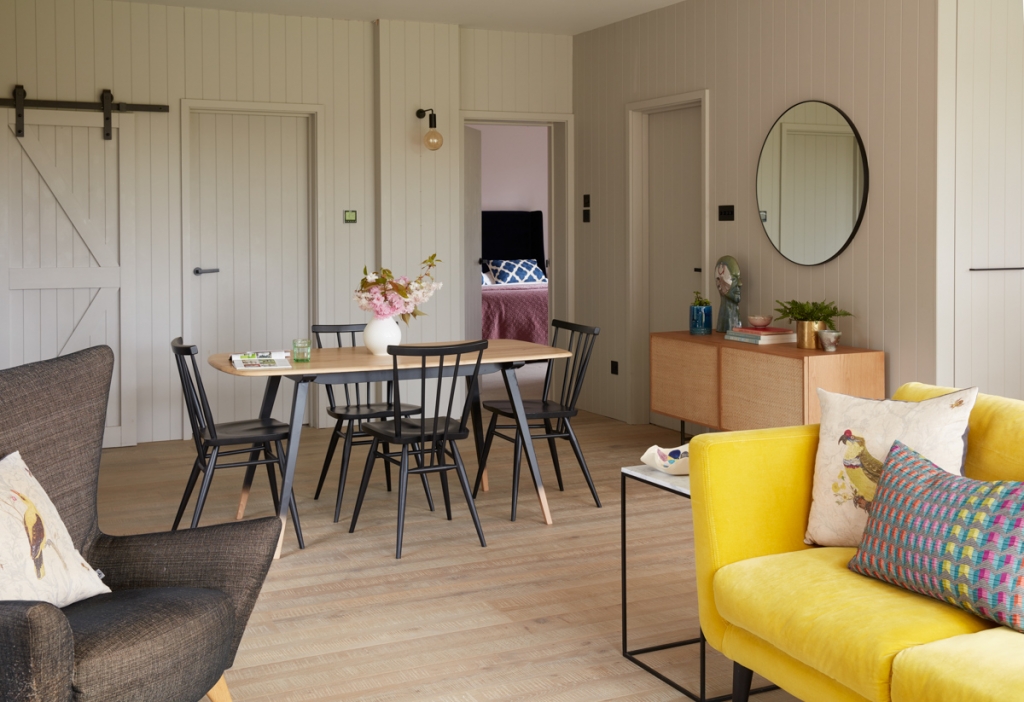Why under floor heating is on every interior designers wish list

As a designer I hate radiators. First up are ugly, and try as product designers might, they are never and nor should they ever be a design feature in my view. They are inevitably always in annoying places, causing headaches for layouts and messing up window dressings. So under floor heating is the ultimate dream in terms of the aesthetics of a room but coupled with the fact it feels glorious underfoot and is a more efficient way to heat your home it’s a total no brainer.
A common misconception is that water under floor heating is only an option for new builds or when you’re doing major renovations due to the disruption it causes. But you can easily and relatively affordably retrofit under floor heating and this is what we plan to do with the renovation of our Victorian Sussex farmhouse. We fitted ProWarm floating under floor heating to my Mums Annex build last spring and throughout the winter I was super impressed with how well it heated her home- to the envy of us in our cold damp farmhouse with no central heating! Coupled with some really serious insulation her home is so incredibly warm and cosy it has us all green with envy. Naturally, the more insulated your home then the more efficient the heating system and so this is something to think about too when you are renovating.

Icynene spray foam insulation is used on top of celotex insulation board around all the exterior walls and ceiling to produce a thick layer of insulation throughout.
Our house is turn of the century Victorian Sussex tile hung farmhouse. Like lots of older properties it struggle to retain heat and feel cosy and that’s something we really want to tackle in the renovation. Having a low level, even heat throughout the floor makes for a cosier feel. Not to mention pottering down to the kitchen in the morning and feeling toasty underfoot while you make the morning brew.
So in an existing property you need to be looking at retro-fit floating under floor heating. There is no one size fits all and we use Under floor heating store for product recommendations and purchasing. My husband (who owns a residential building business Ark Builders) has used them on many residential projects and find them to be reliable experts in their field with a comprehensive range of products to suit most projects. I also got to meet Steve one of the company owners on DIYSOS big build in Sheppey in 2016, which was possibly one of our most challenging projects to date as we built a whole house in just 9 days. I don’t recommend installing under floor heating in such rushed conditions but Steve and his team really rose to the challenge and certainly made it happen which we’ll be eternally grateful for!

Ian from Contant Hot water, repaired the underfloor heating for DIYSOS Sheppey, after the builders punctured it! Building a whole house from the ground up in 9 days isn’t without it’s glitches! However this shows an underfloor heating system set in the floor screed (with some clever repairs!).
We installed ProWarm floating floor panels in our Annex refurb, which essentially allows you to have water under floor heating system where there is already an existing sub floor. With a new build or extension its wise to look at sinking the under floor heating system under the screed as this acts as a thermal store, thereby increasing the efficiency of the heating. But when your renovating an existing build then a floating underfloor heating system is the least disruptive option.

plan supplied by under floor heating store showing the plumber how to lay out the system throughout the property. You can see the kitchen and bath areas are left blank so the heating moves around the kitchen island etc
The floating foil faced panels require no drying time and just go straight down on a level floor ready to accommodate the pipes. You simply supply Under floor heating store a measured scale drawing of your floor space and they create a layout plan for your plumber on how to layout the piping. It looks massively complicated to the untrained eye! You can have it all going back to one single thermostat or run separate circuits which allows you to control the temperature in different zones of the house. This was ideal for mum as with a one level home she could have her bedrooms on a different control to the open plan area.

ProWarm foil backed underfloor heating panels float on top of the existing floor. Quick and easy to install they hold the pipework in position.
We used Prowarm 18mm floating floor system using these grooved and foiled insulation panels. It comes in 18mm board and 25mm board and is super suitable to lay laminate, LVT or engineered wood flooring on top. You can also lay carpet but it’s worth noting its less efficient this way as the carpet and underlay acts as an insulator but this is what my Mum wanted in both bedrooms so we went with that. In the open plan area we used Quickstep hardwood Imperio 1628 rough piled oak. Again Quickstep is one of my go-to flooring brands. I love the wide range of finishes and a year after installation it’s keeping its good looks impeccably well.

The multi room system allows the open plan space to be on a different thermostat from the two separate bedrooms
However water under floor heating systems are cheaper to run, suitable for larger areas like open plan spaces and can be controlled on multi room thermostat options. Ideally you’d install them at the building stage, where they are fitted to the sub floor, which then works as a thermal store. Now while our project was a renovation and reconfiguration, we had the sub floor in place so were looking for a retro fit option. This is where the floating floor system come into play and it’s well worth checking out if you are renovating an existing property and would like all the benefits of under floor heating. It’s what I’ll also be putting in my own Victorian Sussex farmhouse, after experiencing how well it has performed in the annex.

Underfloor heating is a great option in open plan areas. Where there are less walls to mount radiators, it becomes essential, and provides a warm even temperature throughout
There are so many options for under floor heating that getting the right system can be a headache. But talk to your plumber or use the helpful team at Under floor Heating store and you’ll be matched with the right one. This is my personal no strings attached recommendation.
Under floor heating can be used to simply warm your floor or act as a primary heat source, replacing your radiators. It comes in 2 main forms, electric systems and water systems. When coming to make tour choice here are some pros and cons
Water under floor heating
Water systems use of a length of pipe set in the floor, a heat source and a pump to pump the water through the pipes to heat your floor.
Pros:
- Very economical to run (half the cost of electric UFH)
- Safe to use with Rugs and Bean bags without damaging the under floor heating (although these items will reduce the efficiency)
- longer life span (look out for 50 years guarantee)
Cons:
- Overlay systems raise your floor height more than electrical
- Slightly more expensive to install in comparison to electric.
Floating Under floor Heating:
Pros
- Low profile solutions can be fitted onto existing floors with minimal disruption.
- Quick response time to heat up.
- Foil faced to help heat the floor above evenly.
- No need to wait for screeds to dry unlike with a conventional screed UFH system. A screed can take a millimeter per day to dry, sometimes up to 100 Days.
Cons
- Does not have the thermal storage that a screed would have.
- Minimal insulation as retrofit – New build would have minimum 100mm insulation.
- Slightly more expensive to install in comparison to electric.
Electric Under floor Heating
Electrical systems use electrical cables to generate heat. Electric under floor heating is easy to install and it has the minimum floor heights so great for retro fits and bathrooms as it creates the least disruption.
Pros
- Quick and easy to Install
- Can be retrofitted with minimum disruption
- Will only increase floor height as little as 3mm.
- 25year warranty on heating cables.
Cons
- Cannot use under rugs or bean bags without damaging the heating system
- Can be expensive to run
You can see more about our underfloor heating installation over on my Youtube channel here









 After
From beige to boom! My bathroo
After
From beige to boom! My bathroo





